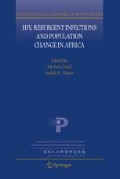There have been a series of nationally representative surveys in Zambia between 1996 and 2003 that contain information on sexual behaviour in the general population. These show that risky sexual behaviours have become less common. There is evidence of a decline in reported early sexual debut. In a generalized epidemic the sexual behaviour of married people, and the similarity of behaviour patterns within couples, may become an important determinant of HIV transmission. Using Demographic and Health Survey data, the behaviours of married couples were compared between 1996 and 2001/2. Over this period there was less change in the risk behaviour of married couples than in the total survey population. The risk behaviours that showed a significant decline were sex with more than one partner in the last year (men only) and sex before the age of 15. Married couples became more similar to each other with respect to sex before the age of 15. Marital status changed over this period. Monogamously married couples in 2001 were less likely to have the same history of previous marriage than those in 1996. There was an increase in the proportion of men in monogamous second marriages. The distribution of women’s marital status did not change. These changes are consistent with increases in adult mortality (a consequence of increases in HIV prevalence) and suggest that marital dynamics are changing in Zambia. Marriages (either polygamous or monogamous) in which the man has been married before are becoming more common. HIV testing is uncommon: in 2001 only 3% of couples had both been tested for HIV infection. HIV prevalence has remained stable in Zambia between 1996 and 2001. If the declines in risk behaviour that have been observed in this period do not eventually lead to a decline in HIV prevalence this may indicate that the transmission patterns of HIV have changed. The data on marital history are not sufficiently detailed to fully characterize the changes that have taken place in Zambia. However the results suggest that this is an area which needs further investigation; HIV prevention and surveillance efforts may need to pay more attention to married people as behaviour change and increases in HIV associated mortality begin to change the dynamics of marriage.
Access this chapter
Tax calculation will be finalised at checkout
Purchases are for personal use only
Preview
Unable to display preview. Download preview PDF.
References
Central Statistical Office Republic of Zambia, Ministry of Health (1997). Zambia Demographic and Health Survey, 1996. (Calverton, Maryland: Central Statistical Office/Macro International)
Central Statistical Office Republic of Zambia (1999). MEASURE evaluation. Zambia Sexual Behaviour Survey 1998 with selected findings from the quality of STD services assessment; 1999
Central Statistical Office Republic of Zambia, MEASURE Evaluation. Zambia Sexual Behaviour Survey 2000; 2002
Central Statistical Office Republic of Zambia, Central Board of Health Republic of Zambia, Macro O. (2003). Zambia demographic and health survey 2001/02. (Calverton, Maryland: Central Statistical Office/Central Board of Health/ORC Macro)
Central Statistics Office Republic of Zambia, Ministry of Health (2004). MEASURE Evaluation. Zambia Sexual Behaviour Survey 2003. (Chapel Hill, North Carolina: Central Statistics Office/Central Board of Health/MEASURE Evaluation Project)
Slaymaker, E. & Buckner, B. (2004). Monitoring trends in sexual behaviour in Zambia, 1996–2003. STI,80(Suppl II), ii85–ii90
Walker, N., Stanecki, K. A., Brown, T., Stover, J., Lazzari, S., Garcia Calleja, J., et al. (2003). Methods and procedures for estimating HIV/AIDS and its impact. The UNAIDS/WHO methods for end of 2001. AIDS, 17(15), 2215–2225
The UNAIDS Reference Group on Estimates Modelling and Projections (2002). Improved methods and assumptions for estimation of the HIV/AIDS epidemic and its impact: Recommendations of the UNAIDS reference group on estimates, modelling and projections. AIDS, 16(9), W1–W14
Auvert, B., Buve, A., Ferry, B., Carael, M., Morison, L., Lagarde, E., et al. (2001). Ecological and individual level analysis of risk factors for HIV infection in four urban populations in sub-Saharan Africa with different levels of HIV infection. AIDS, 15(Suppl 4), S15–S30
United Nations Population Division (2002). World population prospects: The 2002 revision population database. (New York: UN)
StataCorp. (2003). Stata/SE 8.2 for Windows. In 8.2 edn. (College Station, USA: State Corporation)
Gausset, Q. (2001). AIDS and cultural practices in Africa: The case of the Tonga (Zambia). Social Science and Medicine, 52(4), 509–518
Malungo, J.R. (2001). Sexual cleansing (Kusalazya) and levirate marriage (Kunjilila mung’anda) in the era of AIDS: Changes in perceptions and practices in Zambia. Social Science and Medicine, 53(3), 371–382
Allen, S., Meinzen-Derr, J., Kautzman, M., Zulu, I., Trask, S., Fideli, U., et al. (2003). Sexual behavior of HIV discordant couples after HIV counseling and testing. AIDS, 17(5), 733–740
Trask, S. A., Derdeyn, C. A., Fideli, U., Chen, Y., Meleth, S., Kasolo, F., et al. (2002). Molecular epidemiology of human immunodeficiency virus type 1 transmission in a heterosexual cohort of discordant couples in Zambia. Journal of Virology, 76(1), 397–405
Author information
Authors and Affiliations
Editor information
Editors and Affiliations
Rights and permissions
Copyright information
© 2007 Springer
About this chapter
Cite this chapter
Slaymaker, E., Zaba, B. (2007). Sexual Behaviour Change, Marriage and HIV Prevalence in Zambia. In: Caraël, M., Glynn, J.R. (eds) HIV, Resurgent Infections and Population Change in Africa. International Studies in Population, vol 6. Springer, Dordrecht. https://doi.org/10.1007/978-1-4020-6174-5_8
Download citation
DOI: https://doi.org/10.1007/978-1-4020-6174-5_8
Publisher Name: Springer, Dordrecht
Print ISBN: 978-1-4020-6172-1
Online ISBN: 978-1-4020-6174-5
eBook Packages: MedicineMedicine (R0)

